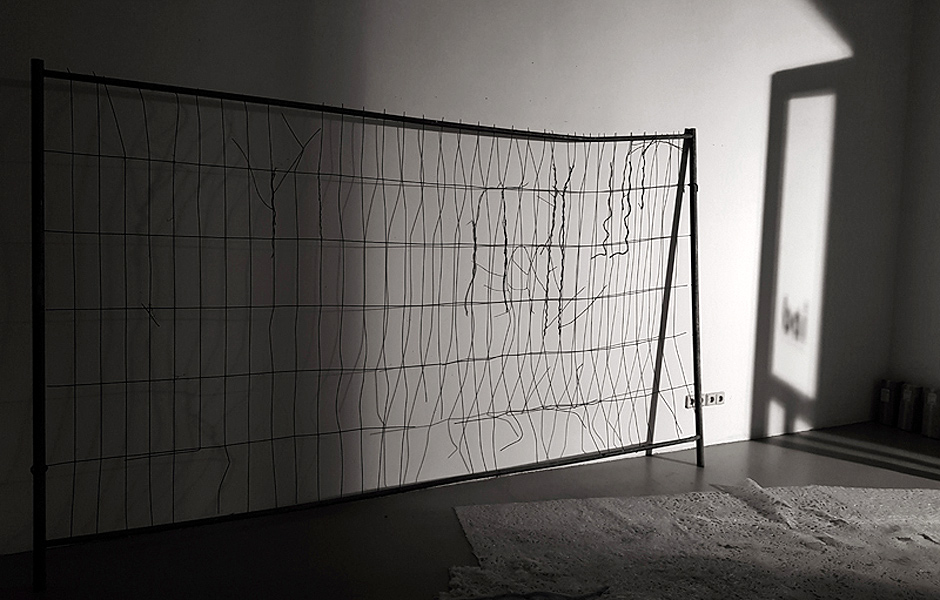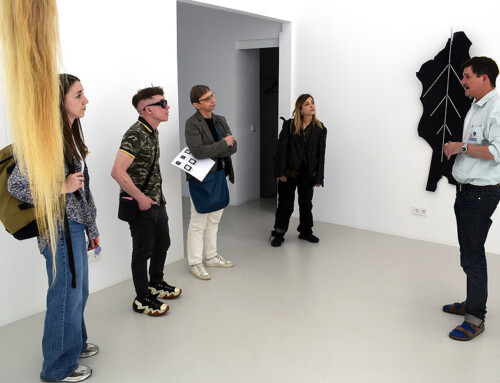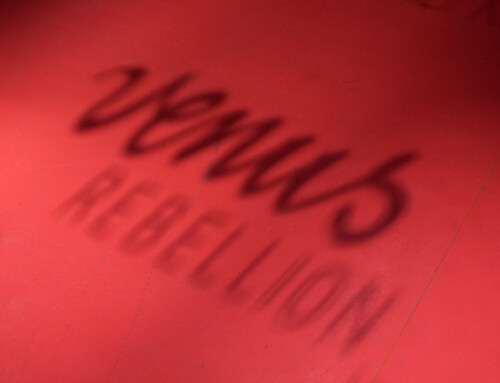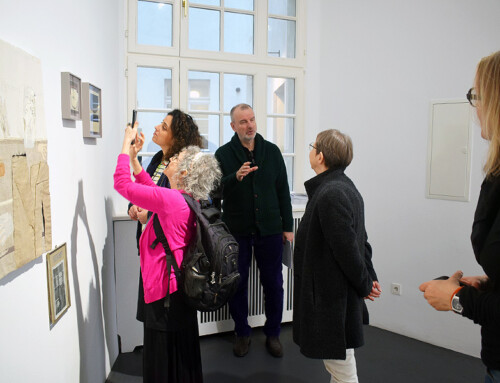May 11 – 15, 2020
Many thanks to the artist Haeshin Chung for realizing the solo exhibition STATIONARY TRAVELLER at 404 | BAI within the Studio Program at BAI | Berlin Artist Residency, Art School & Arts Incubator.
Exhibition Dates: May 11 – 15, 2020
Opening Hours: By appointment
Location: 404 | BERLIN ART INSTITUTE
Address: An der Industriebahn 12–16, 13088 Berlin, building 404, 2nd floor
“I Know That I Know Nothing
The title of this essay is a simplification of a statement Socrates makes in Plato’s Apology. Although he is not recorded as ever having said it, its short, pithy rendition has embedded itself, like so many other inaccuracies, into our cultural fabric. I will continue this fast and loose relationship to fact and now attribute it to Haeshin Chung, though she, like Socrates, is not known to have ever uttered these words. Based on the chronology of artist statements she has made available online, however, she feasibly could have. The unique decision to publish multiple statements, the earliest of which is from 2010, I parallel to the layering of text and images in her drawings and to her practice of covering objects with layers of hot glue. Her semi-diaristic and at times stream-of-consciousness writing invites a contemplation of how art relates to knowledge. And like most relationships, it is a messy one.
Chung is currently working on her PhD at the Hongik University in Seoul, South Korea. This is a tricky position, because the questions of methodology in the visual art PhD parallel questions about art’s relationship to knowledge. Since there is no generally accepted answer as to what constitutes artistic knowledge, there is also little consensus on what position this type of knowledge occupies in a university setting where, knowledge is, by and large, discursive. Though visual art has been likened to a language, the relationship remains largely metaphorical. Linguistic patterns, rhetorical strategies and discursive structures can be employed in art but they do not form its skeleton. It is thus illuminating, that in an artist statement from 2017, translated with the help of Google, Chung suggests that objects are “firmly defending” the possibility of “meaning or meaninglessness” against “the violence of language and ideas.”
For her exhibition in the project space of the Berlin Art Institute, Stationary Traveller, Chung used a Paul Éluard poem, pour vivre ici, as her statement. The poem was written at the end of WWI, in which Éluard served as a medic and as an infantry member. It is a description of how one might survive in an unlivable world. The tone and content forms an easy parallel with the Corona pandemic, at the height of which Chung completed her residency. Her show consisted of glass bottles placed on the window sill, each half-covered in a different shade of colored glue. This was her version of the rainbows people put up in windows throughout the pandemic to cheer themselves up, she explains with an almost chagrined smile. More dominant was part of a large, discarded fence that she dragged in from outside and propped against the wall. Like Cady Nolan’s fences, the thing accentuates feelings of entrapment and prohibition, easily evocative of the enforced lockdown. On the floor was what looked like a quilted blanket made of glue—a safety blanket? Two glue-encased packages sat abandoned in a corner. “Stationary traveller” is clearly an understatement. In reality the artist was stuck in quarantine in a country she doesn’t know, whose language she doesn’t speak.
This interpretation, though real, might just enact the aforementioned “violence of language and ideas.” The poem sets an interpretive stage-set that forces a premature closure. It allows us to define the objects and explain them away, thus diverting the gaze from the thing to its representation. But if the object indeed defends meaning(lessness) against the “violence of language,” how might it do so? In another artist statement Chung cites Samuel Beckett as an influence.¹ With what he called a “literature of the unword,”² he defended the word against the violence of language, I’d like to suggest, by treating the word as an object rather than a mode of expression or communication. In Beckett’s writing, especially in his short story Lessness, words and sentences act like blocks butting against each other and promising, through their repetition and staccato rhythm, an articulation of meaning. Rather than being connected, individual words push together and stick to the tip of one’s tongue, but never take flight. They cannot articulate. They simply insist on their presence. For Beckett, language was an inadequate conveyor of meaning. To chart out its limitations and illusions, he turned it in on itself, so as to get to know it, though not necessarily develop a consistent body of knowledge.
In another statement Chung quotes Mike Gane’s remark on materializing nothingness then paraphrases him with an error that is not technically incorrect, but is uncommon for native English speakers. She says that one of her main concerns is “how to materialize the nothingness.”³ The addition of the definite article already pushes nothingness toward its proposed materialization. It makes it seem like nothingness has set boundaries, as if it were that thing sitting in the corner just waiting to stand up. This approach to the thing, thingness, or no-thingness, parallels Beckett’s approach to the word. It is a type of getting to know the thing as such, no matter what sort of thing it may be. Walter Benjamin described this peculiar relationship to the object in his portrayal of the collector’s relationship to his acquired items: he “studies and loves them as the scene, the stage, of their fate.”⁴
Discarded, unwanted, and used objects are those to which Chung gravitates and then encases in layered threads of colored or transparent hot glue. In covering things that have lost their meaning, she reinserts them into a system of signification as aesthetic and conceptual objects. Ready-mades come to mind, but the similarity is misleading. In a conversation with me, she explains that she finds the discarded items beautiful. I even get the impression that she feels she is rescuing them. Covering them in glue is an act of preservation and even idolization via a type of mummification. Unlike Duchamp, who eschewed the artist’s touch, she often likens herself to an insect who covers its prey, or in the case of a caterpillar, itself, with secretions from its own body. Preservation and death seem to have much in common and in Chung’s practice, the gallery is not much more than a graveyard. Once an object winds up there, it can never go back to its former life within the hierarchy of things.
In Stationary Traveller, Chung shows the glue without the object for the first time. She exhibits a large “blanket”—a sort of Shroud of Turin that exists as an imprint of the thing it was impressed upon. The blanket was made by attempting to cover a found appliance, only to have the glue peel off in sheets. Chung then decided to keep making sheets using different types of liquid adhesive and later stitch them together into something akin to a crochet throw-over, a quilt, lace, plastic or skin. The expansive sheet references her layered drawings more than her objects, and in turn, it reflects the surface of the found fence she brought into the gallery. The semi-transparent layer is the thread binding all her works together. It simultaneously acts as interpretive mediator and divisive screen. Like Beckett’s (un)words, which endeavored “to express ‘nothing’ while simultaneously conveying ‘everything’,”⁵ Chung’s layers are liminal objects that intimate nothing, yet attempt to convey every thing through a purposelessness, self-contemplative materiality.
In Plato’s Apology Socrates’ misquoted statement stems from his effort to disprove the proclamation of the oracle at Delphi. She claims that he is the wisest man there is, which he deems to be false, because, he claims he has no wisdom “small or great.”⁶ He proceeds to ask politicians, poets, craftsmen and other men of knowledge about their wisdom and concludes, that they only know the rules of their craft, but when it comes to the meaning of the craft or why they do it, they have nothing to say. In the end, Socrates realizes he is better off than they are, because while they think that they know something, they in fact do not, and he, at least, knows that he doesn’t know.
Among the many makers, users, careful observers of things, it is the artist who might also knowingly say that she, in fact, does not know the thing, though perhaps she does know nothing. As a creator of objects that are the “scenes of their fates,” the artist’s contribution to knowledge may in fact be a contribution to its impossibility. To quote Marlene Dumas: “Art is a translation of that which you do not know, but of which you want to convince others or rather, that which no-one knows, but by which everyone can be seduced to believe…”⁷ ” (Text by courtesy of Dagmara Genda)
¹ Haeshin Chung, Artist Statement for The Space of Non-existence at the Czong Institute for Contemporary Art (2018) https://cicamuseum.com/haeshin-chung-solo-exhibition/
² Kathryn White, Beckett and Decay (New York: Continuum Books, 2009) p. 131
³ Chung loc. cit.
⁴ Walter Benjamin, Illuminations (New York: Schocken Books, 1969, 2012 ) p. 60
⁵ White loc. cit.
⁶ Plato, Apology, translated by Benjamin Jowett, available online from http://classics.mit.edu/Plato/apology.html (1994-2009)
⁷ Marlene Dumas in Theories and Documents of Contemporary Art: a sourcebook of artists’ writings, eds. Kristine Stiles and Peter Selz (Los Angeles: University of California Press, 2012) pp. 308-311
More information on the Haeshin Chung Website.
404 | BAI is the display & project space of the BERLIN ART INSTITUTE. 404 is derived from the numeric designation of the building while also referring to the well-known HTTP status code: 404 Not Found, familiar from the internet.

















